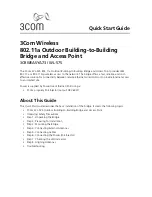
5 - 115
21. Define the following
General
MLD snooping parameters for the Bridge VLAN configuration:
Multicast Listener Discovery
(MLD) snooping enables a controller, service platform or access point to examine MLD packets
and make forwarding decisions based on content. MLD is used by IPv6 devices to discover devices wanting to receive
multicast packets destined for specific multicast addresses. MLD uses multicast listener queries and multicast listener
reports to identify which multicast addresses have listeners and join multicast groups.
MLD snooping caps the flooding of IPv6 multicast traffic on controller, service platform or access point VLANs. When
enabled, MLD messages are examined between hosts and multicast routers and to discern which hosts are receiving
multicast group traffic. The controller, service platform or access point then forwards multicast traffic only to those
interfaces connected to interested receivers instead of flooding traffic to all interfaces.
22. Define the following
Multicast Router
settings:
23. Set the following
MLD Querier
parameters for the profile’s Bridge VLAN configuration:
24. Select the
OK
button located at the bottom right of the screen to save the changes. Select
Reset
to revert to the last saved
configuration.
Enable MLD Snooping
Enable MLD snooping to examine MLD packets and support content forwarding on this
Bridge VLAN. Packets delivered are identified by a single multicast group address. Multicast
packets are delivered using best-effort reliability, just like IPv6 unicast. MLD snooping is
enabled by default.
Forward Unknown
Unicast Packets
Use this option to either enable or disable IPv6 unknown multicast forwarding. This setting
is enabled by default.
Interface Names
Select the ge or radio interfaces used for MLD snooping.
Multicast Router Learn
Mode
Set the
pim-dvmrp
or
static
multicast routing learn mode. DVMRP builds a parent-child
database using a constrained multicast model to build a forwarding tree rooted at the
source of the multicast packets. Multicast packets are initially flooded down this source
tree. If redundant paths are on the source tree, packets are not forwarded along those
paths.
Enable MLD Querier
Select this option to enable MLD querier on the controller, service platform or access point.
When enabled, the device sends query messages to discover which network devices are
members of a given multicast group. This setting is enabled by default.
MLD Version
Define whether MLD version
1
or
2
is utilized with the MLD querier. MLD version 1 is based
on IGMP version 2 for IPv4. MLD version 2 is based on IGMP version 3 for IPv4 and is fully
backward compatible. IPv6 multicast uses MLD version 2. The default MLD version is 2.
Maximum Response
Time
Specify the maximum response time (from 1 - 25,000 milliseconds) before sending a
responding report. Queriers use MLD reports to join and leave multicast groups and receive
group traffic. The default setting is 1 milliseconds.
Other Querier Timer
Expiry
Specify an interval in either
Seconds (
60 - 300) or
Minutes
(1 - 5) used as a timeout interval
for other querier resources. The default setting is 60 seconds
Summary of Contents for WiNG 5.7.1
Page 1: ...WiNG 5 7 1 ACCESS POINT SYSTEM REFERENCE GUIDE ...
Page 2: ......
Page 3: ...WING 5 7 1 ACCESS POINT SYSTEM REFERENCE GUIDE MN001977A01 Revision A April 2015 ...
Page 4: ...ii WiNG 5 7 1 Access Point System Reference Guide ...
Page 24: ...1 4 WiNG 5 7 1 Access Point System Reference Guide ...
Page 36: ...2 12 WiNG 5 7 1 Access Point System Reference Guide ...
Page 72: ...3 36 WiNG 5 7 1 Access Point System Reference Guide ...
Page 470: ...5 386 WiNG 5 7 1 Access Point System Reference Guide ...
Page 472: ...6 2 WiNG 5 7 1 Access Point System Reference Guide Figure 6 1 Configuration Wireless menu ...
Page 624: ...7 46 WiNG 5 7 1 Access Point System Reference Guide ...
Page 724: ...9 56 WiNG 5 7 1 Access Point System Reference Guide ...
Page 783: ...12 35 Figure 12 46 Device Summary screen 4 Click File Management ...
Page 816: ...12 68 WiNG 5 7 1 Access Point System Reference Guide ...
Page 1006: ...13 190 WiNG 5 7 1 Access Point System Reference Guide ...
Page 1026: ...14 20 WiNG 5 7 1 Access Point System Reference Guide ...
Page 1028: ...A 2 WiNG 5 7 1 Access Point System Reference Guide ...
Page 1089: ......
Page 1090: ...MN001977A01 Revision A April 2015 ...
















































